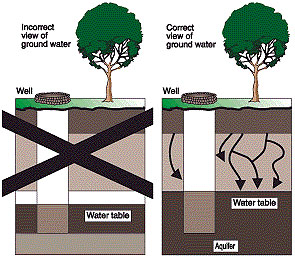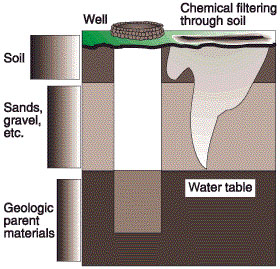Groundwater is like a very large, saturated underground sponge made of sands and gravels. Water seeps through this sponge at varying rates, depending on the permeability of the sands or gravel (Figure 1). Water filters down through the soil until it reaches the aquifer. The water table indicates the top level of groundwater, or aquifer.
Aquifers may be present very near the ground surface or more than 1,000 feet down. Factors that affect the potential for contamination of groundwater include:
- Depth to the water
- Soil type and geology of the land
- How rapidly waters from the surface can reach the groundwater
Chemicals in soils may eventually show up in groundwater at some place or time (Figure 2). However, not all materials end up in groundwater and not all the materials that do get into it are in hazardous forms.
Groundwater contamination only becomes a problem when chemicals:
- Are present in large enough quantities
- Dissolve in water
- Leach far enough through soil to reach the groundwater
How far chemicals leach depends on the type of material and the soil type. Soils such as clay can attract and hold large amounts of chemicals. Chemical materials can be changed through soil microbial and chemical reactions, reducing or eliminating their toxicity. As soils become more porous, like sands, chemicals flow more directly through these soils and may enter a shallow water table.
 Figure 1
Figure 1
Incorrect, left, and correct views of groundwater.
 Figure 2
Figure 2
Soil filter effect.
This publication — previously named WQ24 Aquifers and Soil Filter Effect: Nitrogen in the Environment — was written by Karen DeFelice, former associate extension agronomist; Nyle Wollenhaupt, former state extension agronomist; and Daryl Buchholz, former state extension agronomist. This material is based upon work supported by the United States Department of Agriculture, Extension Service, under special project number 89-EWQI- 1-9203.